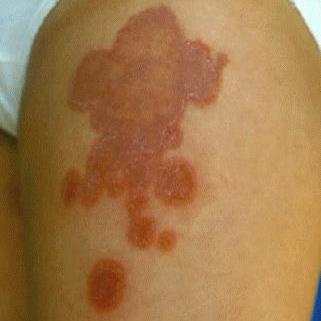
Are you wondering how you get ringworm? We’ll tell you about the different causes of ringworm, which, by the way, is really caused by a type of fungus, not a worm. It’s just called ringworm due to its ring-like appearance.
We’ll also tell you how to treat the condition if you do get it. Since the condition can cause a great deal of itching, most people want to get rid of it as soon as possible. Of course, prevention is better than any treatment, so if you can, avoid possible sources of infection.
So How do You Get Ringworm?
There are several ways you can get it. All involve your skin coming into contact with the fungus. You can get ringworm on any part of your body, including your scalp, face, torso, limbs, feet, and groin area (where it is sometimes referred to as jock itch). Ringworm is highly contagious so it’s easy to get it.
- Direct skin-to-skin contact with someone that has ringworm is probably the most common way it is spread.
- Direct skin-to-skin contact with an animal that has ringworm is another way you can get the condition. It’s fairly common to get it from pet cats or dogs, but you can get it from many other animals, too, including rabbits, ferrets, horses, pigs, and goats.
- You can also get ringworm through indirect contact, by touching an object that was used by someone with the condition. For instance, you can get ringworm by using a towel that was used by someone with ringworm. You can also get ringworm from things like clothing, bed linens, shoes, hats, or hairbrushes. You can even get ringworm by walking barefoot where someone with ringworm of the feet has recently walked, especially damp places like locker room floors, showers, or pool decks. Ringworm of the feet is often referred to as athlete’s foot for just that reason. Avoid sharing personal items and wear flip flops or shower shoes to avoid getting ringworm in these ways.
- The least common of all causes of ringworm is in contact with infected soil. It’s possible to get ringworm this way, but it would probably require lengthy contact with highly infected soil.

How do You Get Rid of Ringworm?
Now that you know how you get ringworm, you probably want to know how to get rid of it. There are a number of treatments available but unfortunately, it can take a while to treat ringworm. It doesn’t go away overnight.
Ringworm is usually treated with topical over-the-counter medications, like clotrimazole 1% (Lotrimin AF Cream and Mycelex), miconazole 2% (Lotrimin AF Liquid Spray, Lotrimin AF Powder, Lotrimin AF Powder Spray, Micatin and Monistat-Derm), and terbinafine 1% (Lamisil AT). Most are used twice daily and should be used for at least a minimum of two weeks, even if your condition seems better sooner than that. Follow the directions on the package and talk to your pharmacist if you have any questions.
In severe cases, especially when you have ringworm of the scalp, oral antifungal medications like griseofulvin (Grifulvin V, Gris-Peg) or terbinafine (Lamisil) might be prescribed. Oral medications may be needed for several weeks and you should take the full prescription, even if your ringworm seems to clear up before all the medication is gone. A prescription shampoo is often recommended to treat ringworm of the scalp, as well. See your doctor if over-the-counter medications don’t work or if you have questions about the best treatment for you.
Our Preferred Over-The-Counter Remedy
Our preferred over-the-counter remedy for ringworm is Phytozine. It contains an antifungal medication called tolnaftate, which works quickly to kill the fungus that causes ringworm, along with a number of natural ingredients that work together to soothe scaly skin and relieve the itching and discomfort that accompany ringworm. To learn more about Phytozine, just follow the link.
